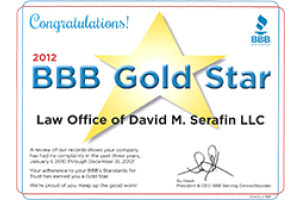Colorado Homeowners are Eliminating Second Mortgages More than Ever
May 24, 2011
By: David M. Serafin
Due to the weakened housing market nationwide and in Colorado, many homeowners who once enjoyed the comfort of having equity in their properties now find themselves underwater and financially struggling. The fact that Colorado homeowners are prohibited by Congress and the Bankruptcy Code from cramming down a first mortgage (down to the value of the property) for those intending to keep their home has hardly helped sustain the American Dream.
But, before contemplating surrendering your home (and discharging personal liability for any deficiency) in a bankruptcy, be aware that you can still keep your home in bankruptcy, avoid foreclosure and, in some instances, eliminate the second mortgage and the accompanying monthly payment.
During the housing boom, Section 506 of the Bankruptcy Code was seldom used by bankruptcy lawyers because homeowners typically were able to cover the second mortgage with their home equity. But, Section 506 now allows a homeowner in a chapter 13 to strip off a second (or third) mortgage if a written valuation shows that the property value is less than the first mortgage balance alone. The now eliminated second mortgage (assuming that the chapter 13 plan is successfully completed) is deemed to be unsecured debt – similar to credit card debt or medical bills – whereby a debtor pays back anywhere from 0% to 100%, depending on their monthly income/expenses under the Means Test.
For instance, if you have home valued at $300,000 and 2 mortgages with principal balances owed of $320,000 and $40,000, the second mortgage with the $40,000 balance owed can be eliminated in chapter 13. If the numbers support application of Section 506 and a chapter 13 bankruptcy is filed, we advise debtors to immediately stop making the second mortgage payment while they complete a 3 to 5 year repayment plan (which may include payment for all other unsecured debts, except for student loans). If the plan payments have successfully been made, the Colorado Bankruptcy Court will enter a Discharge Order.
The most advantageous use of Section 506 concerns a below median income debtor (e.g. has passed the Means Test) with a 3 to 5 year monthly payment which is less than the now foregone monthly mortgage payment. Regardless, even for bankruptcy filers with a higher income (who do not pass the Means Test), stripping off a second mortgage usually eliminates a significant portion of the unsecured debt to be paid back in conjunction with other unsecured debt in the form of a consolidated monthly plan payment.
In essence, stripping off a second mortgage allows a chapter 13 bankruptcy debtor to focus on making regular monthly payments on a first mortgage (without an on-going second mortgage payment while attempting to work out a loan modification for the first mortgage).





